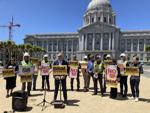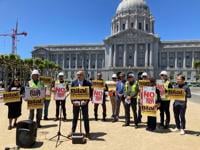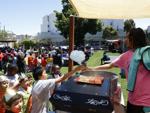Downtown San Francisco deep freeze threatens COVID restoration | Enterprise

Winter has settled upon downtown San Francisco.
That is roughly equivalent to 22.5 Salesforce Towers — and experts expect the empty space to grow.
The effects of so many workers not coming to offices have been far-reaching, hurting building owners dependent on rents, retail businesses that need foot traffic, public transit agencies that need passengers and city tax revenues that fund public services.
City officials have responded with a range of initiatives aimed at stimulating business activity, making streets cleaner and safer, and converting underutilized buildings into housing. Still, the vacancy numbers have continued to climb as companies have shed space.
“The situation is dire,” said John Bryant, CEO of the Building Owners and Managers Association of San Francisco. “I’d like to present it in a different fashion, but there’s real challenges ahead of us, especially within the commercial real estate world in San Francisco.”


John Bryant, CEO of Building Owners and Managers Association, as seen in his office in San Francisco on Wednesday, Jan. 17, 2024.
Craig Lee/The Examiner
Bryant says he remains bullish on San Francisco’s long-term future, but he wants to see The City help downtown businesses more — with tax relief, for example. That might be a stretch given that The City is facing a deficit, but without downtown rebounding, Bryant said deficits could get bigger.
Meanwhile, the question looms whether the current downturn is fundamentally different from others in The City’s dramatic boom-and-bust history because of remote work, a new factor on top of other macroeconomic influences, such as inflation, higher interest rates, and layoffs — notably by tech companies.
Connor Kidd, president and CEO of The Swig Company in San Francisco, expressed confidence that The City will rebound.
“I feel like everyone forgot,” Kidd said. “It’s cyclical, and we happen to be in a down cycle right now. It’s nothing that hasn’t happened before. We’ve had ups and downs.”


Connor Kidd, President and CEO of the Swig Company, inside 350 California Street office building owned by the Swig Company, in San Francisco on Thursday, Jan. 18, 2024.
Craig Lee/The Examiner
Kidd’s company, together with SKS Partners, bought the 22-story building at 350 California Street in August for $61.1 million, or $205 per square foot — a remarkable deal given that replacement costs for such buildings can easily exceed $1,000 per square foot, according to an analyst with the real estate company JLL.
“I think right now is an amazing time to focus on high-quality buildings in the financial core,” Kidd said.
Tenants might be getting deals — including free rent — but they are signing leases to be in modern, centrally located buildings near transit, Kidd said. However, older buildings and those that are not well located or lack amenities such as fitness facilities or modern conference rooms will face challenges, he said.
BXP, a publicly traded owner and operator of premium office buildings that include Salesforce Tower and the Embarcadero Center, expressed similar sentiments in a November disclosure report.“Sentiment surrounding return-to-office and the effects on office buildings is worse than the reality of what BXP is experiencing,” it said.
For the wider market, however, the path looks dark.


Nigel Hughes, senior director of market analytics at CoStar Group in San Francisco on Tuesday, Jan. 16, 2024.
Craig Lee/The Examiner
Nigel Hughes, senior director of market analytics at CoStar, a commercial real-estate services firm, said the decrease in occupied office space in 2023 in the San Francisco metro area, including San Mateo County, was more than 9.2 million square feet. Much of the vacated space has come from tech companies offering large blocks for sublease.
That is comparable to what happened in New York City, a far larger market, said Hughes, who considers a wider swath of properties than other real-estate companies in his research.
The total came after three straight years of “negative net absorption,” meaning more space was available for rent at the end of the year than at the beginning, reaching 13.5 million square feet, for a four-year combined total of almost 22.8 million square feet, according to CoStar.
By comparison, the total amount from 2008 to 2010 during the Great Recession was just under 5.2 million square feet, and though the total was 9.8 million in 2001 after the dot-com crash, that lasted only one year, CoStar data show
Hughes said he does not expect the San Francisco office market to return to its pre-pandemic highs in the foreseeable future; it might bottom out by the end of 2024 and then gradually improve.

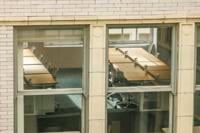
Vacant office at 465 California Street in San Francisco on Wednesday, Jan. 10, 2024.
Craig Lee/The Examiner
“We expect there to be higher rates of vacancy for quite a few years,” Hughes said. “We expect a lot of office space to be turned into something else, especially because there’s no demand for it, so it’s a very long-term process to turn this around.”
Nicholas Bloom, a Stanford University economics professor who has written extensively about remote work, said the effects of corporate return-to-work mandates have plateaued nationally.
“Return-to-office died in 2023,” Bloom said.
One reason is that companies have benefited financially from the new regime, he said. A forecast that a major leasing company shared with Bloom showed it would take until 2033 for office occupancy levels to recover to pre-pandemic levels in San Francisco, he said.
San Francisco was relatively hard-hit because it has a high proportion of workers who could do their jobs remotely, particularly tech workers, as well as long commutes many are glad to avoid. The metro area is the nation’s second-most flexible regarding remote-work policies after San Jose, according to Scoop, a San Francisco company that tracks working practices.
The San Francisco metro area has consistently had among the lowest office-occupancy rates of 10 cities tracked by security company Kastle Systems, which counts access-badge swipes. Its data showed the area’s occupancy averaging just 41.5 percent for the week ending Jan. 10 — meaning, on average, there were nearly 144,000 fewer office workers than before COVID-19.
The effect on property values resulting from office vacancies, in turn, has been dramatic.
A study updated in December by academics from three universities estimated the “novel disruptive shock” of remote work, even with workers in-office several days a week, had caused U.S. office values to decline 46 percent from 2019 to the end of 2022.
Among the hardest-hit areas was San Francisco, which lost $31.3 billion in value, behind Palo Alto-Sunnyvale at $33.9 billion, said the study, conducted by researchers from NYU Stern School of Business, University of North Carolina at Chapel Hill and Columbia Business School.
Fitch Ratings, noting that U.S. office availability was at an all-time high, issued a note the same month warning about rising delinquencies in office commercial-mortgage-backed security loans. The agency highlighted San Francisco’s central business district for having recent office-building sale prices 66 percent below a 2020 peak.
In line with Kidd’s comments, Fitch highlighted a “bifurcation” in the market, with commercial real estate in larger central business districts — particularly older buildings — “highly vulnerable” because a “structural shift” to hybrid working had reset valuations, making refinancing more challenging.
Dan McNamara, a New York hedge-fund founder who scored big in the past betting against shopping malls, has been targeting the office sector, including in San Francisco. He founded his New York firm, Polpo Capital, in 2021 as the lasting nature of remote work was becoming clear.
McNamara agreed that newer buildings will fare better but said owners of older buildings will face mounting difficulties as leases expire, more office space comes on the market, vacancies persist and it becomes more difficult to refinance mortgages, which can lead to defaults, especially if a recession emerges.
McNamara cited data showing $3.7 billion of office loan balances maturing this year in the San Francisco metro area. That number increases to $4.5 billion when including 2025, he said.
The high vacancy crisis in San Francisco was exacerbated by the fact that a lot of offices were built during the recent tech boom, McNamara said.
“It really was the perfect storm — unfortunately for San Francisco,” McNamara said, though he agreed with others that modern, well-located buildings with amenities will still likely get rented.
Vacant buildings can translate over time into less property-tax revenue for The City, as well as less business taxes on rents and employee head counts and sales tax generated by the spending that office workers do.

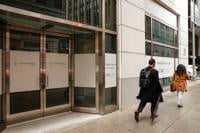
Vacant storefront at 100 Montgomery Street in San Francisco on Tuesday, Jan. 16, 2024.
Craig Lee/The Examiner
City budget officials in December forecast that “patterns of remote work, along with high-interest rates, would lead to declining commercial and residential real estate values, affecting property and transfer taxes.”
The prospect of long-term underused office buildings — and the implications for surrounding business and city finances — have fueled urgent calls from various quarters for a robust rethinking of what The City’s downtown should look like, particularly by converting underused office buildings to housing.
The upheaval in the office market has presented an opportunity to reimagine San Francisco’s business center as something more than just a workplace, said Sujata Srivastava, the housing and planning policy director for SPUR, an urban planning nonprofit.
Wade Rose, president of the business group Advance SF, agreed.
“What is the urban core going to be now?” Rose asked. “We need more reasons to come downtown than simply coming to work.”
During one of The City’s most consequential year in recent memory, perhaps no area faces as many challenges as downtown San Francisco.


